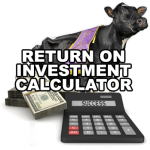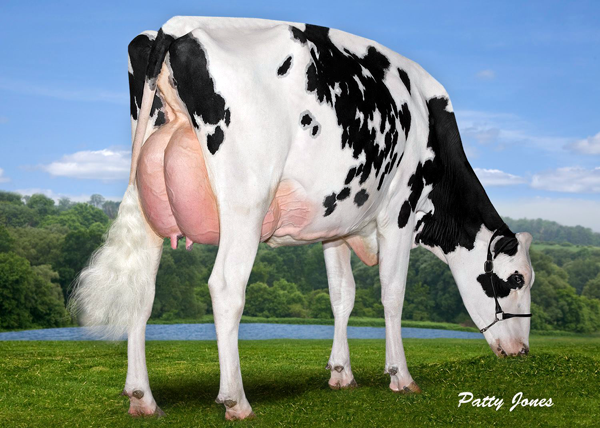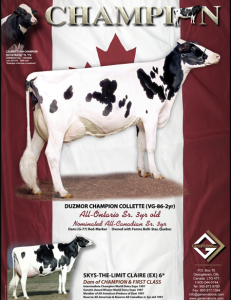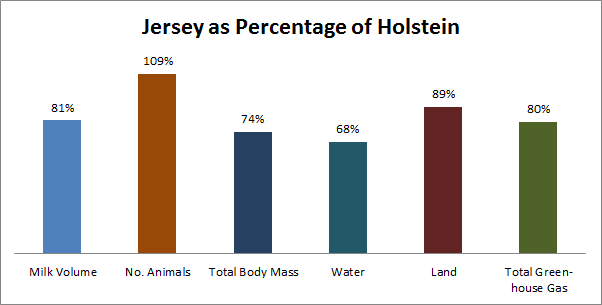For years GP-84-2YR was the kiss of death when it came to marketing and selling genetics. However, along comes genomics and it seems that GP is good enough. Nevertheless, the question it has me asking is “Is Good Plus Good Enough?”
I can still remember when Summershade Icebreak Luke, was the #1 LPI cow in Canada. The problem was she was scored GP-83-2YR. The A.I. companies where not sure if they should even sample bulls from her and how would they convince their members to use them in their young sire programs. Then came along Summershade Igniter and Summershade Inquirer and A.I. companies took the chance. While hindsight is 20/20, maybe they should have passed. On the female side, Icebreak had 34 daughters classified and only 7 of them going VG. We ourselves had one of those daughters Summershade Icemarti. While she did score VG, it was not until her 2nd lactation, long past her peak marketing time. In the past, we have purchased many daughters out of GP 83 and 84 two year olds, expecting them to go VG before our purchase calved in. It has proven to be a risky move, but one that could have paid off big time. On the male side Icebreak had six sons enter A.I. service but none where ever returned to service.
On the flip side, I can also remember when we first purchased into the Braedale Gypsy Grand family and many people around us had concerns about her GP-83-2YR dam. While there was a very good reason why Moonriver never went VG, we still found ourselves having to explain things many times. Then along came Second Cut, Baler Twine, Freelance and Goodluck and we found that changed everything.
As we all know genomics has changed the name of the game, and we now see A.I. companies sampling high genomic sires irrelevant of their score or the score of their dam. With that in mind, I decided to take a look at the current high index dams that are NOT scored VG. The following is what I found.
The Story in the US
In the US, there are three GP cows on the Top 25 GTPI Cows List (GP-83-or Higher). Leading the way is BEN-AKERS PLANET LUISE26-ET, she the #3 GTPI cow and the #1 NM cow scored over 83 points. While Luise is from the Ricecrest Luke Lisa family and has solid type numbers, her genomic values for type are actually lower than her parent average and yet she still has a son at Alta Genetics, Ben-Akers AltaRazzle. Joining Luise on the top GTPI list at #18 is SURE-VIEW MP PLANET LEXI. Lexi is from the M&M-Pond-Hill Leadman Luba family and is scored GP-83-2YR. Similar to Luise, Lexi has high genomic values compared to her parent average but yet again has conformation scores that just meet expectations. Unlike Luise, it appears to this point that Lexi does not have any sons currently in A.I.. The third member of the list is SULLY PLANET MANITOBA , this GP-83-2YR is out of the great brood cow, Sully Shottle May the former #1 GTPI and GLPI cow of the breed. Of course May is believed to have more offspring genomic tested over 2200 & 2300 GPTI than any other cow in the breed. Unlike the other two GP 2yr olds on the top list, Manitoba has outstanding type numbers and her genomic values are actually higher than her parent average. It’s these outstanding values that have her with at least three sons currently in A.I., SULLY HART MERIDIAN-ET and SULLY HART MUNICH-ET at Semex, and SULLY ALTABRANDON-ET at Alta Genetics.
The Canadian Story
Much like the US list the #3 spot on the Canadian List is held by a GP-83-2YR, Benner Planet Jakova-ET. Being a Planet from a Goldwyn, Jakova has strong parent average for type and has strong genomic values as well. Coming from the Benner Luke Jean family, Jokava has yet to put a son into A.I.. Joining Jokova on the list is Delaberge Planet Lulu. However, on April 25th Lulu was raised to VG-85-2YR, 244 days fresh. Lulu comes from the Bryhill Lindy Lilly family and already has a son at Semex, DONNANDALE LUMI. The third member on the list is Alexerin Oman 993. Of interesting note about 993 is that there are no VG dams anywhere in her pedigree, she has mostly production sires and yet her parent average for conformation is five and her genomic value is a six. Not surprisingly, 993 does not have any sons currently in A.I. The last member on the list is Calbrett Planet Empress. Much like Lulu, Empress has since been moved to VG-86-2YR later in lactation. Empress is from the WABASH-WAY EVETT dam of the popular genomic sire Genervations Eclipse and the same family as Epic and Highway. Given the strong maternal pedigree, Empress has PA of +10 for conformation and actually exceeds that with a +12 for her direct genomic value. Given her increase in score and strong maternal pedigree it is just a matter of time before she has sons in A.I..
The Bullvine Bottom Line
While GP-84-2YR use to be the kiss of death for many marketing and genetic programs, genomics has changed the game. With genomics, we are seeing many GP 83 or 84 cattle used as dams that would have never been touched before. While many will increase in score later in life, many do not, and yet that does not seem to be as big a factor. Many A.I. companies and breeders are more concerned about their genomic values than that of their actual classification score.

Not sure how much to spend on that great 2 year old?
Want to make sure you are investing your money wisely?
Download our Dairy Cow Investment Calculator.













 Space is at a premium for any print ad. How do you get your fellow breeder’s attention when working with such little room? With so much to say and so little room many breeders try to cram in as much text as possible and as many different animals as they can. White space is also an important element to include in your ad. White space is essentially empty space. While it may seem to be a waste of precious space in so small an area, white space actually will make your ad clearer and more easily understood. Remember that, although you are trying to squeeze in all your information, a solid block of text won’t be read at all. Plus, if your ad is clean and uncluttered, it will literally jump off the page when it’s surrounded by ads that are not.
Space is at a premium for any print ad. How do you get your fellow breeder’s attention when working with such little room? With so much to say and so little room many breeders try to cram in as much text as possible and as many different animals as they can. White space is also an important element to include in your ad. White space is essentially empty space. While it may seem to be a waste of precious space in so small an area, white space actually will make your ad clearer and more easily understood. Remember that, although you are trying to squeeze in all your information, a solid block of text won’t be read at all. Plus, if your ad is clean and uncluttered, it will literally jump off the page when it’s surrounded by ads that are not. A Picture Is Worth A Thousand Words
A Picture Is Worth A Thousand Words Balancing Act
Balancing Act




